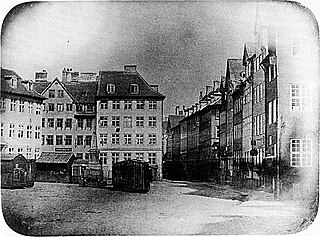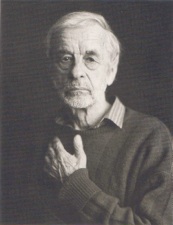
Jacob August Riis was a Danish-American social reformer, "muckraking" journalist, and social documentary photographer. He contributed significantly to the cause of urban reform in the United States of America at the turn of the twentieth century. He is known for using his photographic and journalistic talents to help the impoverished in New York City; those impoverished New Yorkers were the subject of most of his prolific writings and photography. He endorsed the implementation of "model tenements" in New York with the help of humanitarian Lawrence Veiller. Additionally, as one of the most famous proponents of the newly practicable casual photography, he is considered one of the fathers of photography due to his very early adoption of photographic flash.

How the Other Half Lives: Studies among the Tenements of New York (1890) is an early publication of photojournalism by Jacob Riis, documenting squalid living conditions in New York City slums in the 1880s. The photographs served as a basis for future "muckraking" journalism by exposing the slums to New York City's upper and middle classes. They inspired many reforms of working-class housing, both immediately after publication as well as making a lasting impact in today's society.

The Ashcan School, also called the Ash Can School, was an artistic movement in the United States during the late 19th-early 20th century that produced works portraying scenes of daily life in New York, often in the city's poorer neighborhoods.

A tenement is a type of building shared by multiple dwellings, typically with flats or apartments on each floor and with shared entrance stairway access. They are common on the British Isles, particularly in Scotland. In the medieval Old Town, in Edinburgh, tenements were developed with each apartment treated as a separate house, built on top of each other. Over hundreds of years, custom grew to become law concerning maintenance and repairs, as first formally discussed in Stair's 1681 writings on Scots property law. In Scotland, these are now governed by the Tenements Act, which replaced the old Law of the Tenement and created a new system of common ownership and procedures concerning repairs and maintenance of tenements. Tenements with one or two room flats provided popular rented accommodation for workers, but in some inner-city areas, overcrowding and maintenance problems led to shanty towns, which have been cleared and redeveloped. In more affluent areas, tenement flats form spacious privately owned houses, some with up to six bedrooms, which continue to be desirable properties.

Mulberry Street is a principal thoroughfare in Lower Manhattan, New York City, United States. It is historically associated with Italian-American culture and history, and in the late 19th and early 20th centuries was the heart of Manhattan's Little Italy.

Street photography is photography conducted for art or inquiry that features unmediated chance encounters and random incidents within public places, usually with the aim of capturing images at a decisive or poignant moment by careful framing and timing. Although there is a difference between street and candid photography, it is usually subtle with most street photography being candid in nature and some candid photography being classifiable as street photography. Street photography does not necessitate the presence of a street or even the urban environment. Though people usually feature directly, street photography might be absent of people and can be of an object or environment where the image projects a decidedly human character in facsimile or aesthetic.

The Museum of the City of New York (MCNY) is a history and art museum in Manhattan, New York City, New York. It was founded by Henry Collins Brown, in 1923 to preserve and present the history of New York City, and its people. It is located at 1220–1227 Fifth Avenue between East 103rd to 104th Streets, across from Central Park on Manhattan's Upper East Side, at the northern end of the Museum Mile section of Fifth Avenue.
The New York State Tenement House Act of 1901 banned the construction of dark, poorly ventilated tenement buildings in the U.S. state of New York. Among other sanctions, the law required that new buildings must be built with outward-facing windows in every room, an open courtyard, proper ventilation systems, indoor toilets, and fire safeguards. One of the reforms of the Progressive Era, it was one of the first laws of its kind in the U.S.
Documentary photography usually refers to a popular form of photography used to chronicle events or environments both significant and relevant to history and historical events as well as everyday life. It is typically undertaken as professional photojournalism, or real life reportage, but it may also be an amateur, artistic, or academic pursuit.
The term vernacular photography is used in several related senses. Each is in one way or another meant to contrast with received notions of fine-art photography. Vernacular photography is also distinct from both found photography and amateur photography. The term originated among academics and curators, but has moved into wider usage.

How the Other Half Dies: The Real Reasons for World Hunger is a book by Franco-American activist Susan George, a member of the Transnational Institute. It was originally published in 1976, not long after the World Food Conference, and has been reprinted several times since.

In Denmark, photography has developed from strong participation and interest in the very beginnings of the art in 1839 to the success of a considerable number of Danes in the world of photography today.
Social documentary photography or concerned photography is the recording of what the world looks like, with a social and/or environmental focus. It is a form of documentary photography, with the aim to draw the public's attention to ongoing social issues. It may also refer to a socially critical genre of photography dedicated to showing the life of underprivileged or disadvantaged people.

Mulberry Bend was an area surrounding a curve on Mulberry Street, in the Five Points neighborhood in Lower Manhattan, New York City. It is located in what is now Chinatown in Manhattan.

Rudy Burckhardt was a Swiss-American filmmaker, and photographer, known for his photographs of the hand-painted billboards that began to dominate the American landscape in the 1940s and 1950s. He was married to Edith Schloss and Yvonne Jacquette. His youngest son is artist Tom Burckhardt.

Columbus Park formerly known as Mulberry Bend Park, Five Points Park and Paradise Park, is a public park in Chinatown, Manhattan, in New York City that was built in 1897.

The Trench in Potter's Field is a black and white photograph produced by Danish-American photographer Jacob A. Riis, probably in 1890, depicting a trench used as a mass grave for tenement residents who died during the period of mass immigration in New York. This photograph was part of the larger work made by Riis to depict the conditions of the lower classes of New York in his photographic and journalistic work.

Lodgers in Bayard Street Tenement, Five Cents a Spot is a black and white photograph taken by Danish-American photographer Jacob Riis, in 1889. It was included in his photographic book How the Other Half Lives, published in 1890.

Street Arabs in the Area of Mulberry Street is a black and white photograph taken by Danish American photographer Jacob Riis, probably in 1890. The designation of street arabs was given back then to homeless children. Riis took several pictures of these children, during the journalistic and photographic work that led to the publication of his landmark book How the Other Half Lives (1890), where they were published with the title of Street Arabs in Sleeping Quarters.

Sabbath Eve in a Coal Cellar, Ludlow Street is a black and white photograph taken by Danish American photographer Jacob Riis probably c. 1890.
















